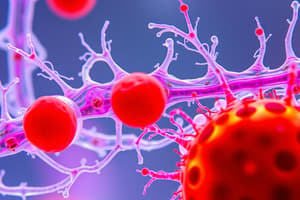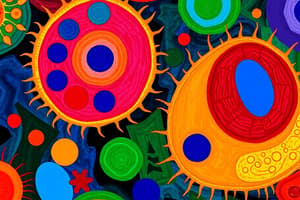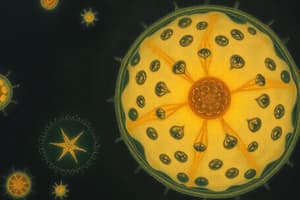Podcast
Questions and Answers
¿Cuál de las siguientes opciones describe mejor la función principal de la membrana plasmática?
¿Cuál de las siguientes opciones describe mejor la función principal de la membrana plasmática?
- Sintetizar las proteínas necesarias para la estructura y función celular.
- Generar la energía necesaria para las funciones celulares.
- Almacenar la información genética de la célula.
- Actuar como una barrera selectiva, controlando el paso de sustancias hacia dentro y fuera de la célula. (correct)
Todas las células de un organismo pluricelular son idénticas en estructura y función.
Todas las células de un organismo pluricelular son idénticas en estructura y función.
False (B)
¿Qué implicación tiene el hecho de que todas las células vivas compartan mecanismos esenciales similares para transferir información?
¿Qué implicación tiene el hecho de que todas las células vivas compartan mecanismos esenciales similares para transferir información?
Sugiere relaciones evolutivas y un origen común.
La unidad más pequeña capaz de llevar a cabo todas las actividades asociadas con la vida es la ______.
La unidad más pequeña capaz de llevar a cabo todas las actividades asociadas con la vida es la ______.
Empareja cada científico con su contribución principal a la teoría celular:
Empareja cada científico con su contribución principal a la teoría celular:
¿Qué molécula utilizan las células para almacenar energía de forma accesible?
¿Qué molécula utilizan las células para almacenar energía de forma accesible?
El citoesqueleto solo sirve para dar soporte estructural a la célula.
El citoesqueleto solo sirve para dar soporte estructural a la célula.
¿Qué es la homeostasis y por qué es importante para las células?
¿Qué es la homeostasis y por qué es importante para las células?
La membrana plasmática contiene bombas y ______ especializados que regulan el paso de materiales.
La membrana plasmática contiene bombas y ______ especializados que regulan el paso de materiales.
¿Cuál es la principal razón por la que la mayoría de las células son microscópicas?
¿Cuál es la principal razón por la que la mayoría de las células son microscópicas?
Un aumento en el volumen de una célula incrementa su área superficial en la misma proporción.
Un aumento en el volumen de una célula incrementa su área superficial en la misma proporción.
¿Cómo contribuyen las microvellosidades a la función de las células epiteliales del intestino delgado?
¿Cómo contribuyen las microvellosidades a la función de las células epiteliales del intestino delgado?
La relación entre el tamaño de la imagen vista con el microscopio y el tamaño real del objeto se conoce como ______.
La relación entre el tamaño de la imagen vista con el microscopio y el tamaño real del objeto se conoce como ______.
¿Qué factor limita la resolución de los microscopios ópticos?
¿Qué factor limita la resolución de los microscopios ópticos?
Robert Hooke observó células vivas por primera vez.
Robert Hooke observó células vivas por primera vez.
¿Qué avances permitieron un mayor estudio de las células a finales del siglo XIX?
¿Qué avances permitieron un mayor estudio de las células a finales del siglo XIX?
Las estructuras internas especializadas dentro de las células se llaman ______.
Las estructuras internas especializadas dentro de las células se llaman ______.
Relaciona la unidad de medida con su tamaño relativo:
Relaciona la unidad de medida con su tamaño relativo:
¿Cuál es la principal función de los microtúbulos en la célula?
¿Cuál es la principal función de los microtúbulos en la célula?
La descripción del trabajo de Leeuwenhoek se limitó al trabajo científico.
La descripción del trabajo de Leeuwenhoek se limitó al trabajo científico.
Flashcards
¿Qué es una célula?
¿Qué es una célula?
Unidad fundamental de la vida capaz de realizar actividades asociadas a la vida.
¿Qué son unicelulares?
¿Qué son unicelulares?
Células con una sola célula.
¿Qué son pluricelulares?
¿Qué son pluricelulares?
Compuestos por muchas células.
¿Qué es la membrana plasmática?
¿Qué es la membrana plasmática?
Signup and view all the flashcards
¿Qué son los orgánulos?
¿Qué son los orgánulos?
Signup and view all the flashcards
¿Qué es un micrómetro (µm)?
¿Qué es un micrómetro (µm)?
Signup and view all the flashcards
¿Qué es un nanómetro (nm)?
¿Qué es un nanómetro (nm)?
Signup and view all the flashcards
¿Qué es la relación área superficial/volumen?
¿Qué es la relación área superficial/volumen?
Signup and view all the flashcards
¿Quién es Rudolf Virchow?
¿Quién es Rudolf Virchow?
Signup and view all the flashcards
¿Quiénes son Schleiden y Schwann?
¿Quiénes son Schleiden y Schwann?
Signup and view all the flashcards
¿Qué es la homeostasis celular?
¿Qué es la homeostasis celular?
Signup and view all the flashcards
¿Qué es un microscopio?
¿Qué es un microscopio?
Signup and view all the flashcards
¿Qué es el aumento en microscopía?
¿Qué es el aumento en microscopía?
Signup and view all the flashcards
¿Qué es el poder de resolución?
¿Qué es el poder de resolución?
Signup and view all the flashcards
¿Quién es Robert Hooke?
¿Quién es Robert Hooke?
Signup and view all the flashcards
¿Quién es Antonie van Leeuwenhoek?
¿Quién es Antonie van Leeuwenhoek?
Signup and view all the flashcards
¿Qué es un microscopio óptico (MO)?
¿Qué es un microscopio óptico (MO)?
Signup and view all the flashcards
Study Notes
- The cell is the smallest unit capable of performing all activities associated with life.
- Cells require essential nutrients and a suitable environment to survive and grow, even in a laboratory setting for extended periods.
- Isolated parts of a cell cannot maintain survival independently.
- Biological systems analysis involves understanding how individual cellular components work together to generate biological systems within the cell.
- The cell itself is a complex biological system where groups of cells form tissues, organs, and organisms.
- Prokaryotes, many protists and fungi consist of a single cell (unicellular).
- Plants and animals are composed of millions of cells (pluricellular).
- Cells are the building blocks of complex multicellular organisms.
- Cells exhibit diversity and versatility, modifying into various forms to perform specialized functions.
- A cell consists of a variety of ions, inorganic and organic molecules, including water, salts, carbohydrates, lipids, proteins, and nucleic acids.
- These molecules are organized to form cell structures and biochemical pathways.
- Genetic information is stored in DNA molecules and replicated faithfully.
- This information is transmitted to each new cell generation during cell division.
- The information contained in DNA encodes specific proteins that determine cell structure and function.
- Cells exchange materials and energy with their environment.
- All living cells require one or more energy sources.
- Cells convert energy from one form to another to perform various activities, from mechanical work to chemical synthesis.
- Cells convert incoming energy into more manageable forms, typically adenosine triphosphate (ATP), a chemical energy storage molecule.
- Chemical reactions converting energy and mechanisms for transferring information are essentially the same in all cells, suggesting evolutionary relationships.
- Modern technology allows cell biologists to use sophisticated tools to understand cell structure and function better.
- Cytoskeleton research has been significantly enhanced by advancements in electron microscopy.
- Microtubules are key components of the cytoskeleton that help maintain cell shape, participate in cell movement, and facilitate material transport within the cell.
The Cell: Basic Unit of Life
- Cells are the building blocks of organisms and exemplify the underlying unity of all living things.
Cell Theory
- Matthias Schleiden and Theodor Schwann concluded that all plants and animals are made of cells using inductive reasoning.
- Rudolf Virchow proposed that new cells form only from the division of pre-existing cells.
- The cell theory states that cells are the basic units of organization and function in all organisms and that all cells come from other cells.
- August Weismann added that all present-day cells can be traced back to ancestral cells, suggesting a common origin for all life.
- Evidence for this common origin lies in the basic structural and molecular similarities among diverse organisms.
Cellular Organization
- Cellular organization and small cell size allow for the maintenance of homeostasis, which is a stable internal environment.
- Cells continuously adjust to maintain internal conditions suitable for biochemical processes, despite external fluctuations in salt concentration, pH, and temperature.
- The plasma membrane surrounds all cells, separating the cell's contents from the external environment and creating a closed compartment with distinct chemical composition.
- The plasma membrane acts as a selective barrier, controlling the exchange of materials between the cell and its surroundings for accumulating needed substances and storing energy.
- Most cells contain internal structures called organelles that are specialized for different metabolic activities.
- These activities include converting energy into usable forms, synthesizing necessary compounds, and producing structures for function and reproduction.
- Each cell has genetic instructions encoded in DNA, concentrated in a defined region of the cell.
Cell Size
- Most cells are microscopic and measured in small units.
- A millimeter (mm) is 1/1000 of a meter.
- A micrometer (µm) is 1/1,000,000 of a meter or 1/1000 of a millimeter, which is the most appropriate unit for measuring cells.
- A nanometer (nm) is 1/1,000,000,000 of a meter or 1/1000 of a micrometer, suitable for measuring cellular components.
Cell Characteristics
- Prokaryotic cells typically range from 1 to 10 µm in length.
- Eukaryotic cells typically range from 10 to 30 µm in diameter.
- Mitochondria are roughly the size of small bacteria.
- Chloroplasts are larger with a length around 5 µm.
- Specialized cells such as certain algae and animal cells can be large enough to observe with the naked eye.
- The human ovum is about 130 µm in diameter.
- Avian eggs are large because they contain significant food reserves.
- Cells are small to maintain homeostasis and facilitate nutrient/waste exchange.
- All materials entering or leaving a cell must pass through its plasma membrane.
- The plasma membrane must be large enough in relation to the cell's volume to meet regulatory demands for material exchange.
- One critical factor determining cell size is the ratio between its surface area (plasma membrane) and its volume.
- As a cell grows, its volume increases faster than its surface area, limiting its size.
- There is an upper limit to cell size, as molecules cannot be transported quickly enough to meet cellular needs.
- Cells would be unable to regulate ion concentrations or export waste effectively.
- Due to their shape, some cells have a favorable surface area-to-volume ratio.
- Variations in cell shape are a strategy to increase the surface area-to-volume ratio.
- Some plant cells increase surface area-to-volume ratio by being long and thin.
- Epithelial cells lining the small intestine have finger-like projections called microvilli, which significantly increase surface area for nutrient absorption.
- Molecules must be transported to different cell compartments, which is more efficient in smaller cells because molecules do not have to travel as far.
Adaptation
- Cell size and shape are adapted to specific functions.
- Some cells like amoebas and leukocytes, can change shape.
- Sperm cells have long, whip-like tails (flagella) for locomotion.
- Nerve cells have long, slender extensions for transmitting messages over long distances.
- Epithelial cells are rectangular and stack like building blocks to form laminar tissues.
Methods for Studying Cells
- Microscopes are one of the most important tools biologists use to study cell structures.
- Robert Hooke first described cells in 1665 using a microscope he created, calling them cells because they resembled monks' living quarters.
- Antonie van Leeuwenhoek examined living cells using self-made lenses, magnifying images over 200 times.
- Leeuwenhoek discovered bacteria, protists, blood cells, and spermatozoa, though he did not share his techniques.
Optical Microscopes
- Optical microscopes have a tube with glass lenses at each end.
- Modern optical microscopes are called compound microscopes because they contain several lenses.
- Visible light passes through the specimen and lenses, creating an image called an optical micrograph (MO).
- A microscope's increase and resolution determine how clear viewers can observe objects through it.
- Increase is the ratio between the object's size as seen through the microscope and its actual size.
- Resolution, or resolving power, is the ability to distinguish between details.
- Resolution is defined as the minimum distance between two points that can be seen separately. Visible light wavelengths restrict the resolution of optical microscopes to details no smaller than the diameter of a small bacterial cell (approximately 0.2 µm).
- Organic chemists and physicists have developed staining and illumination techniques that improve image contrast in microscopy.
Studying That Suits You
Use AI to generate personalized quizzes and flashcards to suit your learning preferences.




